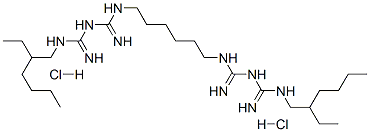Physicochemical Properties
| Molecular Formula | C26H58CL2N10 |
| Molecular Weight | 581.71172 |
| Exact Mass | 580.422 |
| Elemental Analysis | C, 53.68; H, 10.05; Cl, 12.19; N, 24.08 |
| CAS # | 1715-30-6 |
| Related CAS # | Alexidine;22573-93-9 |
| PubChem CID | 102678 |
| Appearance | White to light yellow solid powder |
| Density | 1.1g/cm3 |
| Boiling Point | 658.2ºC at 760mmHg |
| Melting Point | 220.6-223.4ºC |
| Flash Point | 351.8ºC |
| Vapour Pressure | 3.38E-17mmHg at 25°C |
| LogP | 8.604 |
| Hydrogen Bond Donor Count | 8 |
| Hydrogen Bond Acceptor Count | 4 |
| Rotatable Bond Count | 23 |
| Heavy Atom Count | 38 |
| Complexity | 601 |
| Defined Atom Stereocenter Count | 0 |
| SMILES | CCCCC(CC)CNC(=N)NC(=N)NCCCCCCNC(=N)NC(=N)NCC(CC)CCCC.Cl.Cl |
| InChi Key | BRJJFBHTDVWTCJ-UHFFFAOYSA-N |
| InChi Code | InChI=1S/C26H56N10.2ClH/c1-5-9-15-21(7-3)19-33-25(29)35-23(27)31-17-13-11-12-14-18-32-24(28)36-26(30)34-20-22(8-4)16-10-6-2;;/h21-22H,5-20H2,1-4H3,(H5,27,29,31,33,35)(H5,28,30,32,34,36);2*1H |
| Chemical Name | 1-[N'-[6-[[amino-[[N'-(2-ethylhexyl)carbamimidoyl]amino]methylidene]amino]hexyl]carbamimidoyl]-2-(2-ethylhexyl)guanidine;dihydrochloride |
| Synonyms | Alexidine Dihydrochloride; Alexidine 2HCl; |
| HS Tariff Code | 2934.99.9001 |
| Storage |
Powder-20°C 3 years 4°C 2 years In solvent -80°C 6 months -20°C 1 month Note: Please store this product in a sealed and protected environment, avoid exposure to moisture. |
| Shipping Condition | Room temperature (This product is stable at ambient temperature for a few days during ordinary shipping and time spent in Customs) |
Biological Activity
| Targets | PTPMT1 |
| ln Vitro |
With the exception of Candida parapsilosis and Candida krusei, all isolates tested under planktonic conditions showed MIC values of ≤1.5 μg/mL. Alexidine dihydrochloride exhibits activity against most Candida spp. Fascinatingly, clinically significant fluconazole-resistant Candida isolates such as C. albicans (CA2, CA6, and CA10), C. glabrata (CG2 and CG5), C. parapsilosis (CP5), and C. auris (CAU-09 and CAU-03) are all significantly active against alexidine dihydrochloride[1]. When Alexidine dihydrochloride is used to inhibit planktonic growth, it completely stops the fungi being imaged from filamentating or proliferating. Alexidine dihydrochloride is able to decimate at low concentrations (1.5 to 6 μg/mL) mature biofilms of Candida, Cryptococcus, and Aspergillus spp. that are known to be resistant to almost all classes of antifungal drugs. In reality, alexidine dihydrochloride could prevent lateral yeast formation and biofilm dispersal in Candida albicans at concentrations of planktonic MICs that are 10-fold lower—150 ng/mL—than those of Candida albicans[1]. HUVECs and lung epithelial cells are 50% killed by alexidine dihydrochloride at concentrations five to ten times higher than the minimum inhibitory concentration needed to kill planktonically growing fungal pathogens[1]. |
| ln Vivo | decided to concentrate on C. albicans biofilm formation because this fungus has a well-established murine biofilm model that is used to evaluate the efficacy of both new and old antifungal medications. When the drugs are seen under a microscope, the impact they have on the 24-hour-old biofilms that are developing in the mice's jugular vein catheters is evident. The biofilm density in the catheters treated with Alexidine dihydrochloride is considerably lower. In fact, compared to the untreated control biofilms, alexidine dihydrochloride inhibits 67% of the growth and viability of fungal biofilms, according to fungal CFU determination[1]. |
| References |
[1]. Alexidine Dihydrochloride Has Broad-Spectrum Activities against Diverse Fungal Pathogens. mSphere. 2018 Oct 31;3(5). pii: e00539-18. |
Solubility Data
| Solubility (In Vitro) | DMSO :~125 mg/mL (~214.88 mM) |
| Solubility (In Vivo) |
Solubility in Formulation 1: ≥ 2.08 mg/mL (3.58 mM) (saturation unknown) in 10% DMSO + 40% PEG300 + 5% Tween80 + 45% Saline (add these co-solvents sequentially from left to right, and one by one), clear solution. For example, if 1 mL of working solution is to be prepared, you can add 100 μL of 20.8 mg/mL clear DMSO stock solution to 400 μL PEG300 and mix evenly; then add 50 μL Tween-80 to the above solution and mix evenly; then add 450 μL normal saline to adjust the volume to 1 mL. Preparation of saline: Dissolve 0.9 g of sodium chloride in 100 mL ddH₂ O to obtain a clear solution. Solubility in Formulation 2: ≥ 2.08 mg/mL (3.58 mM) (saturation unknown) in 10% DMSO + 90% (20% SBE-β-CD in Saline) (add these co-solvents sequentially from left to right, and one by one), clear solution. For example, if 1 mL of working solution is to be prepared, you can add 100 μL of 20.8 mg/mL clear DMSO stock solution to 900 μL of 20% SBE-β-CD physiological saline solution and mix evenly. Preparation of 20% SBE-β-CD in Saline (4°C,1 week): Dissolve 2 g SBE-β-CD in 10 mL saline to obtain a clear solution. Solubility in Formulation 3: ≥ 2.08 mg/mL (3.58 mM) (saturation unknown) in 10% DMSO + 90% Corn Oil (add these co-solvents sequentially from left to right, and one by one), clear solution. For example, if 1 mL of working solution is to be prepared, you can add 100 μL of 20.8 mg/mL clear DMSO stock solution to 900 μL of corn oil and mix evenly. Solubility in Formulation 4: 10% DMSO+40% PEG300+5% Tween-80+45% Saline: ≥ 2.08 mg/mL (3.58 mM) (Please use freshly prepared in vivo formulations for optimal results.) |
| Preparing Stock Solutions | 1 mg | 5 mg | 10 mg | |
| 1 mM | 1.7191 mL | 8.5953 mL | 17.1907 mL | |
| 5 mM | 0.3438 mL | 1.7191 mL | 3.4381 mL | |
| 10 mM | 0.1719 mL | 0.8595 mL | 1.7191 mL |
